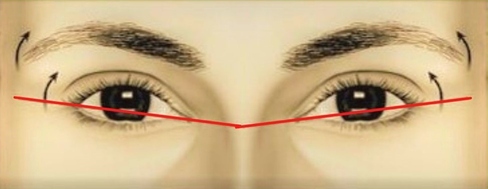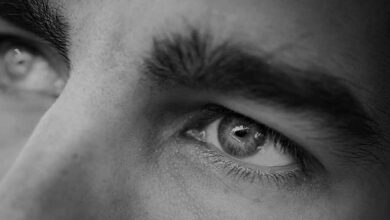
The first thing we notice when we look at someone is their eyes. Generally, eyes are the medium through which we connect with people. Moreover, our eyes speak a great deal about us. Probably that is why eyes are also called the window to the soul. As eyes are so important their features like canthal tilt make a considerable difference to our face.
What Is Canthal Tilt?
Canthal tilt is defined as the angle between the inner eye corner (medial canthus) and the outer eye corner (lateral canthus). We can measure this by drawing an imaginary line.
Positive Canthal Tilt
Positive Canthal Tilt refers to the case where the outer eye corner is 5-8 degrees above the inner eye corner. We can measure the it by drawing an imaginary horizontal line from the lowest point of the inner eye corner and a line bisecting the outer eye corner.
Negative Canthal Tilt
Negative Canthal Tilt is just the reverse of Positive Canthal Tilt. It refers to the case where the outer eye corner is 5-8 degrees below the inner eye corner. We can measure it the same way we measure the Positive Canthal Tilt, but this time the angle will be formed below the horizontal line.
Neutral Canthal Tilt
The case where the outer eye corner and the inner eye corner are at the same level is called Neutral Canthal Tilt. If we draw an imaginary line from the inner eye corner to the outer eye corner, we should get a horizontal line.

What Difference Does It Make?
Appearances of a person generally affect the first impression we form about them. Additionally, it is their facial features why sometimes we find someone alluring as compared to others.
To understand the effect of having Positive Canthal Tilt, a study was conducted by the University of Toronto, Canada (Bashour et al., 2007). The judges were presented with two photographs of the same female person and asked to choose one. Among the two photographs shown, one was with unmodified, and the other was with enhanced Canthal Tilt to make it more positive. It was found that faces with accentuated Canthal Tilt were preferred 93% of the time over unmodified faces.
A Positive Canthal Tilt makes a person look younger. Additionally, our brain perceives it as a sign of youthfulness, happiness, and energy. On the other hand, Negative Canthal Tilt is perceived as a sign of ageing. It also makes the person look tired and old.
However, most people look fine with Neutral Eye Tilts. Many celebrities have beautiful eyes while having Neutral Canthal Tilt.
What Causes a Negative Canthal Tilt?
Generally, ageing, swollen eyelids, and drooping are the causes of Negative Canthal Tilt. Excessive loosen skin at the outer eye corner weighs and brings them down.
However, sometimes the reason can be genetic. You can inherit the it from your patents like any other facial feature.
Improper tongue gestures can also be a cause in some rare cases. If you are a mouth breather, your tongue probably rests at the bottom of your mouth. This can lead to a lack of bone support under your eye area. Mouth-breathing leads to recession of the craniofacial complex, which further leads to reduced support maxilla on your eye area.
Additionally, few external and environmental factors can also affect your eye tilt. For instance, sun damage and smoking can reduce elasticity in the tissues of your lower eyelids, causing them to be saggy.
How to Check Your Canthal Tilt?
The easiest and best way to do it yourself is by simply looking in the mirror with a relaxed head position. Take note of both of your canthi while looking directly into your eyes.
Alternatively, you can take a picture of yourself with a relaxed head position staring straight into the camera.
However, you have to keep in mind that your head is straight while looking in the mirror or taking a picture. Looking up at the camera can make your canthal tilt appear more positive, and looking down at the camera can make it appear more negative than it really is.
On the picture taken, draw a line from your outer eye corner to your inner eye corner on both eyes. The lines should meet on your nose area.
If your outer eye corner is higher than your inner eye corner, you have a Positive Canthal Tilt. The lines will create a slight V-shape near the nose area.

Similarly, if you have a Neutral Tilt, you will find a near-perfectly straight line. There should be no angle where the lines meet.

However, if you have a Negative Canthal Tilt, the lines will create a slope from the inner eye corner to the outer eye corner, and their intersection will form an inverted V-shape.

How to get a positive canthal tilt?
Below are a few ways which can help you reduce your negative canthal tilt and get a positive canthal tilt.
Stop Smoking
Smoking reduces skin elasticity. Reduced elasticity in eyelids tissues can worsen the canthal tilt.
Wear sunglasses or sunscreen
Sun rays also damage skin elasticity which also results in the softness of the skin tissues.
Mewing
It is the technique of flattening out your tongue against the roof of your mouth and placing the tip of your tongue right behind your front teeth without touching them.
As mentioned earlier, improper tongue posture can cause Negative Canthal Tilt as it affects the bone support under your eyes. If your tongue does not rest and push on the palate, your midface does not get any stimulation. Therefore, correcting your tongue posture through mewing can aid in enhancing your eye tilt as it moves your midface up and forward.
Mewing works by moving your cheekbones up and forward. This acts as a support to your eye area and aids in correcting eye tilt. The main downside of mewing is that it takes years to work. Moreover, it works best only when you’re still growing. Also, there is not enough evidence available to support its effect on adults.
Cosmetic plastic surgery
There are many eyelid surgeries that you can get to enhance your canthal tilt. A common type of eyelid surgery generally used to correct canthal tilt is canthoplasty. This procedure repositions your lateral canthus and raises it vertically.
